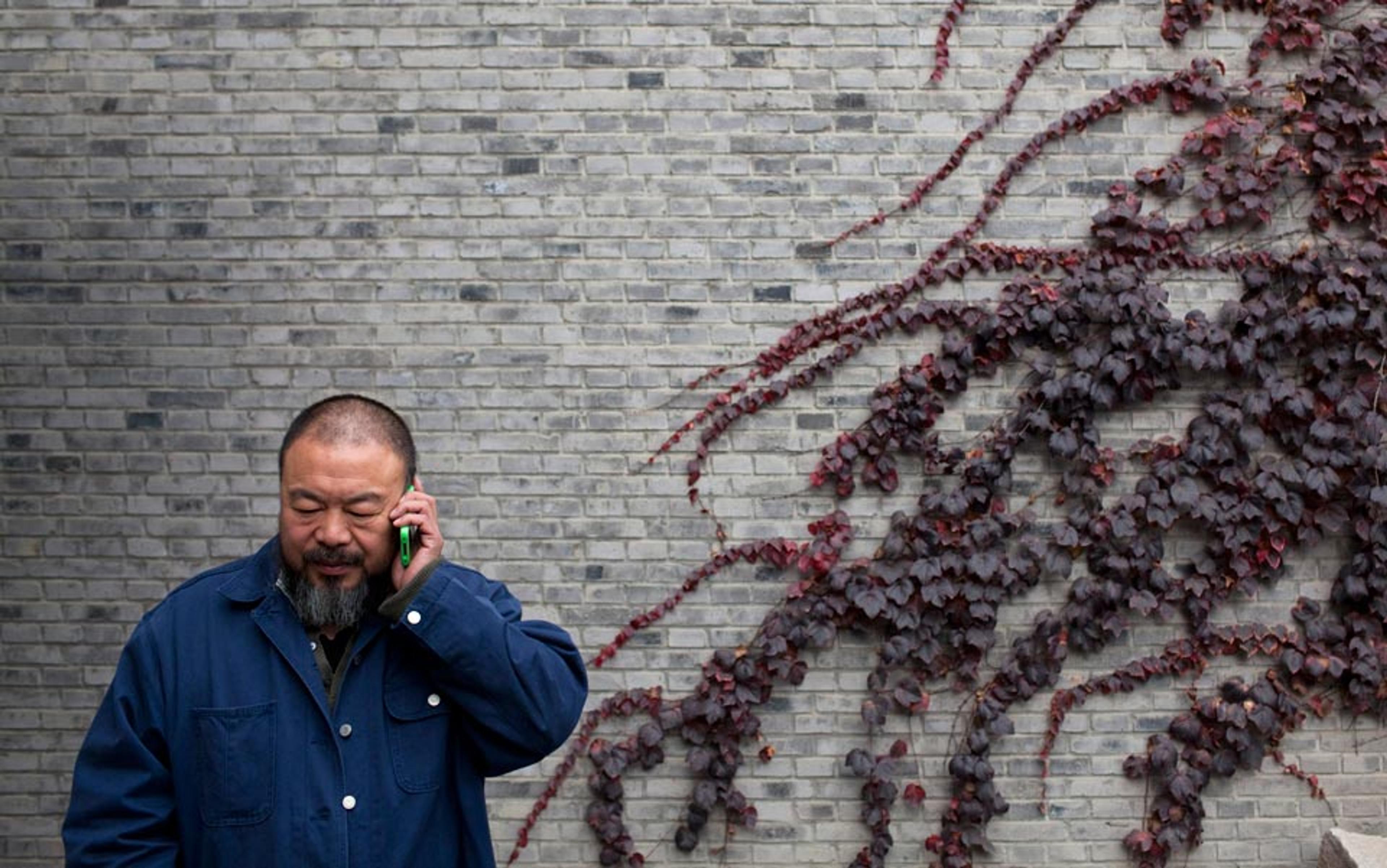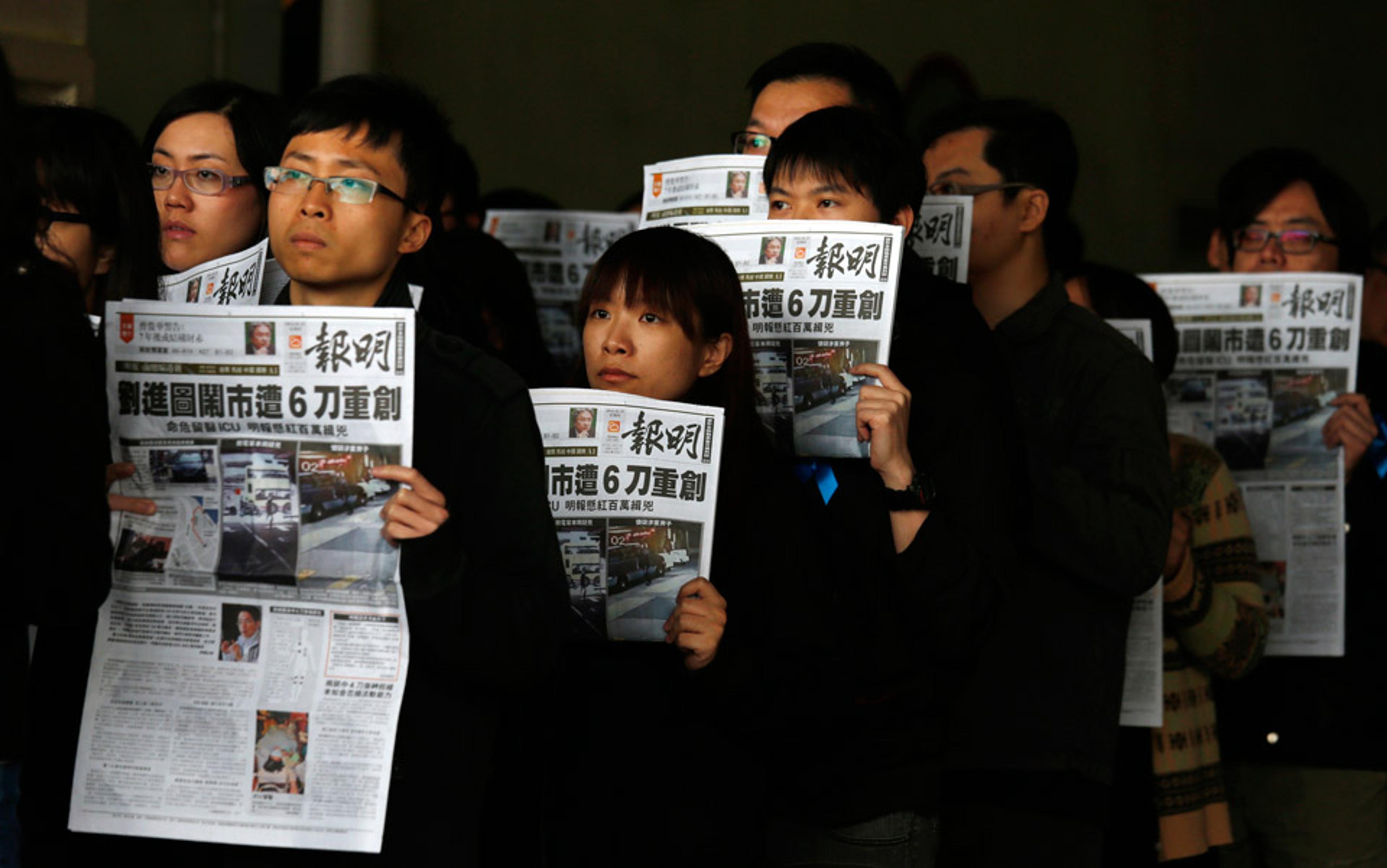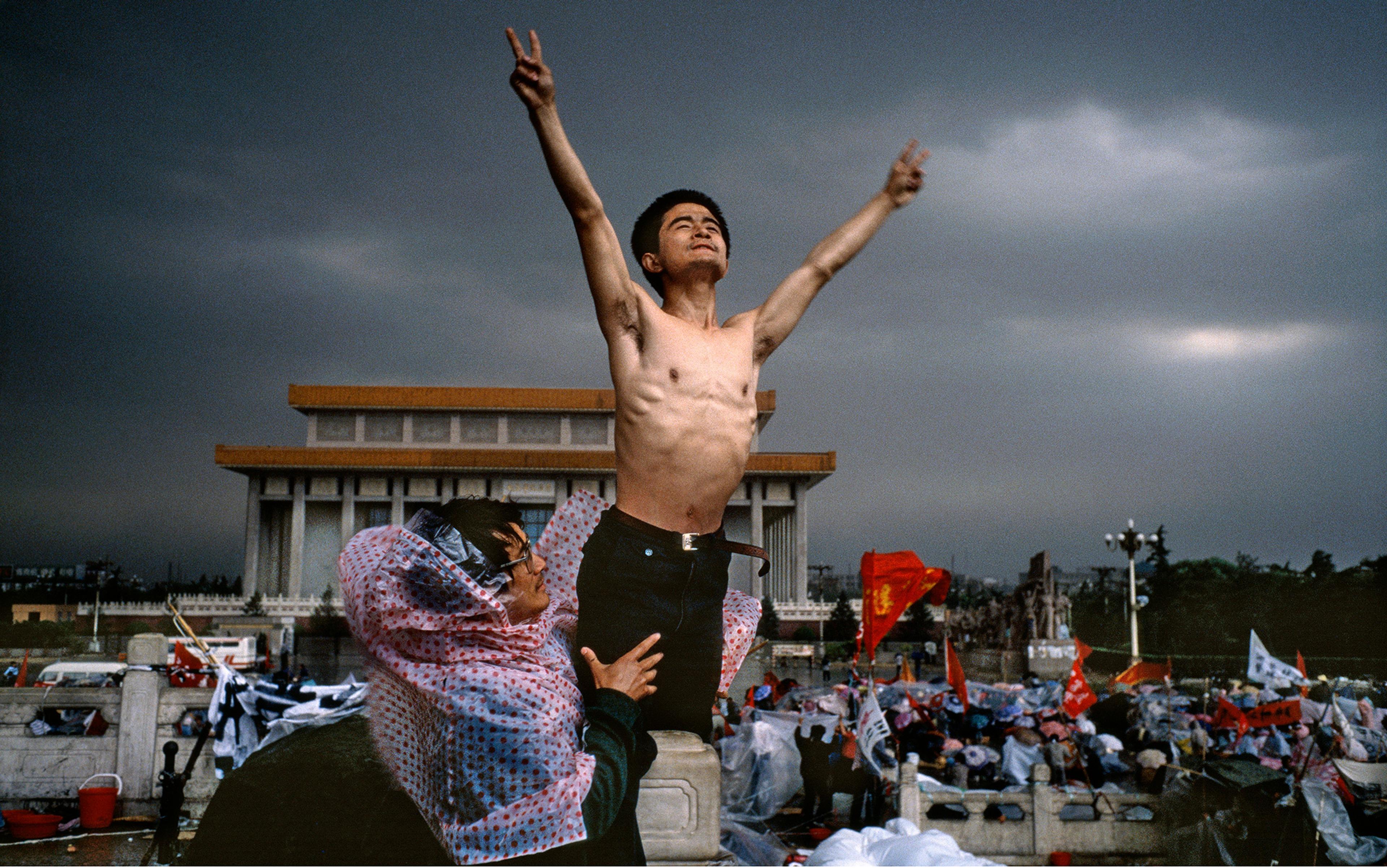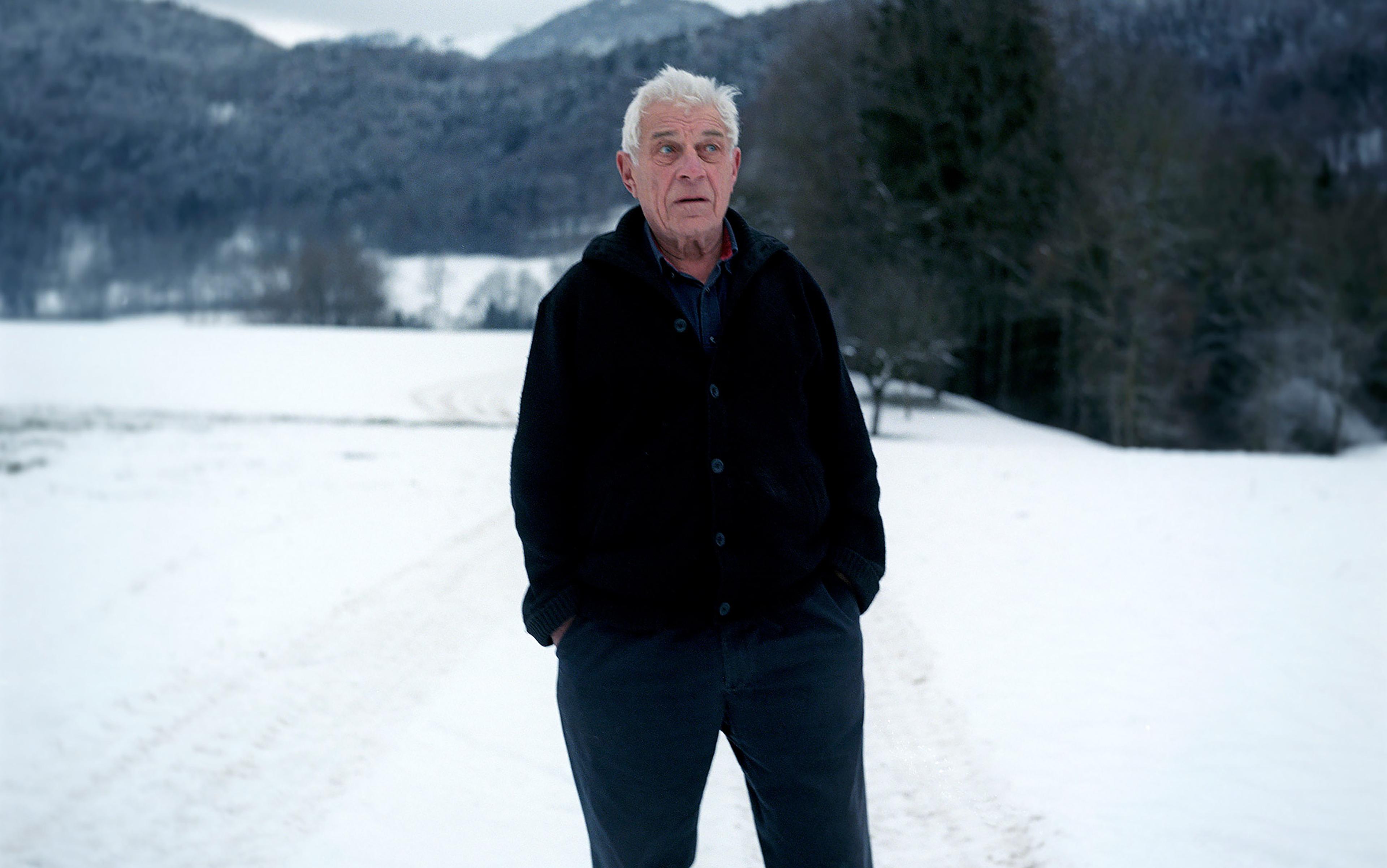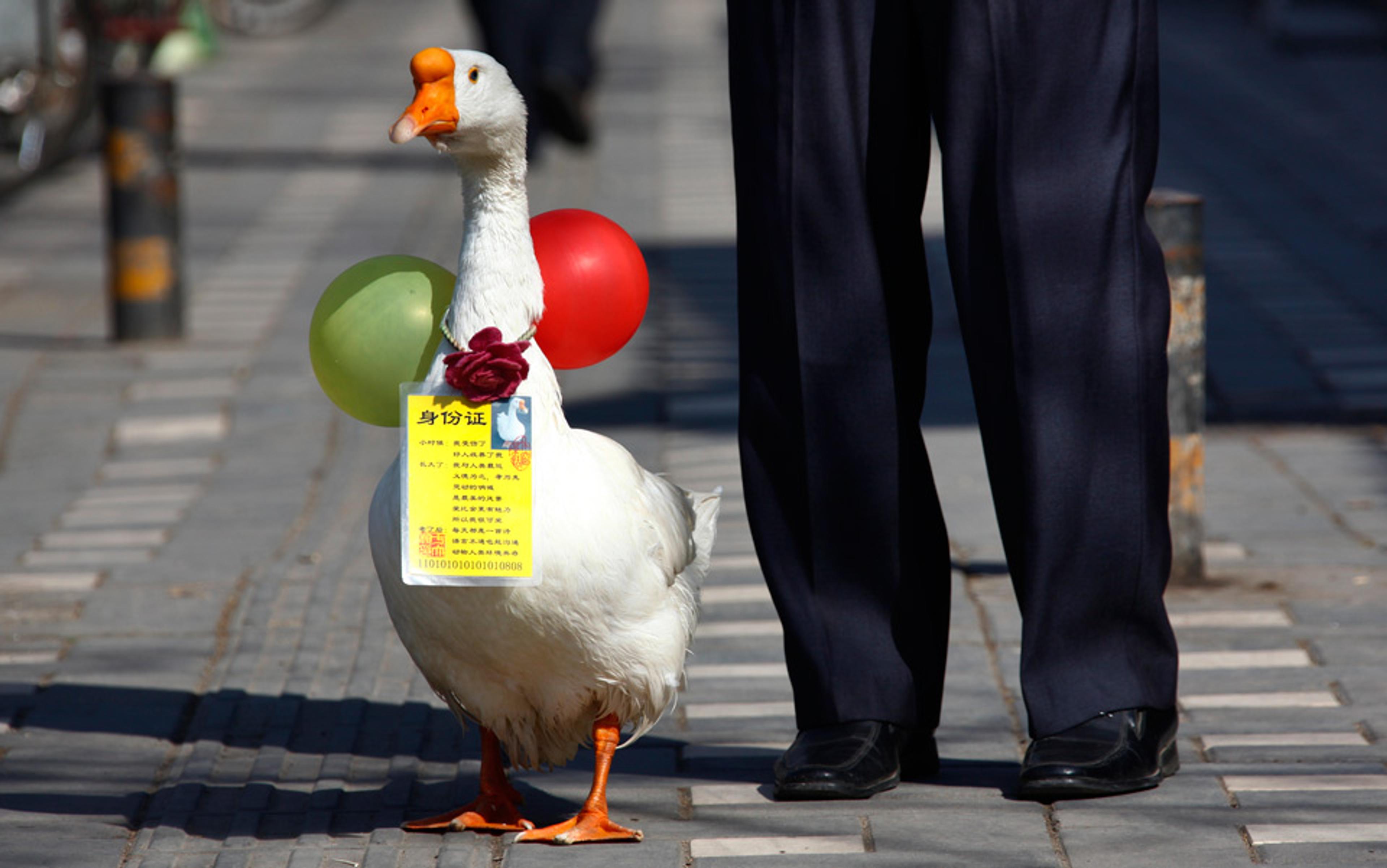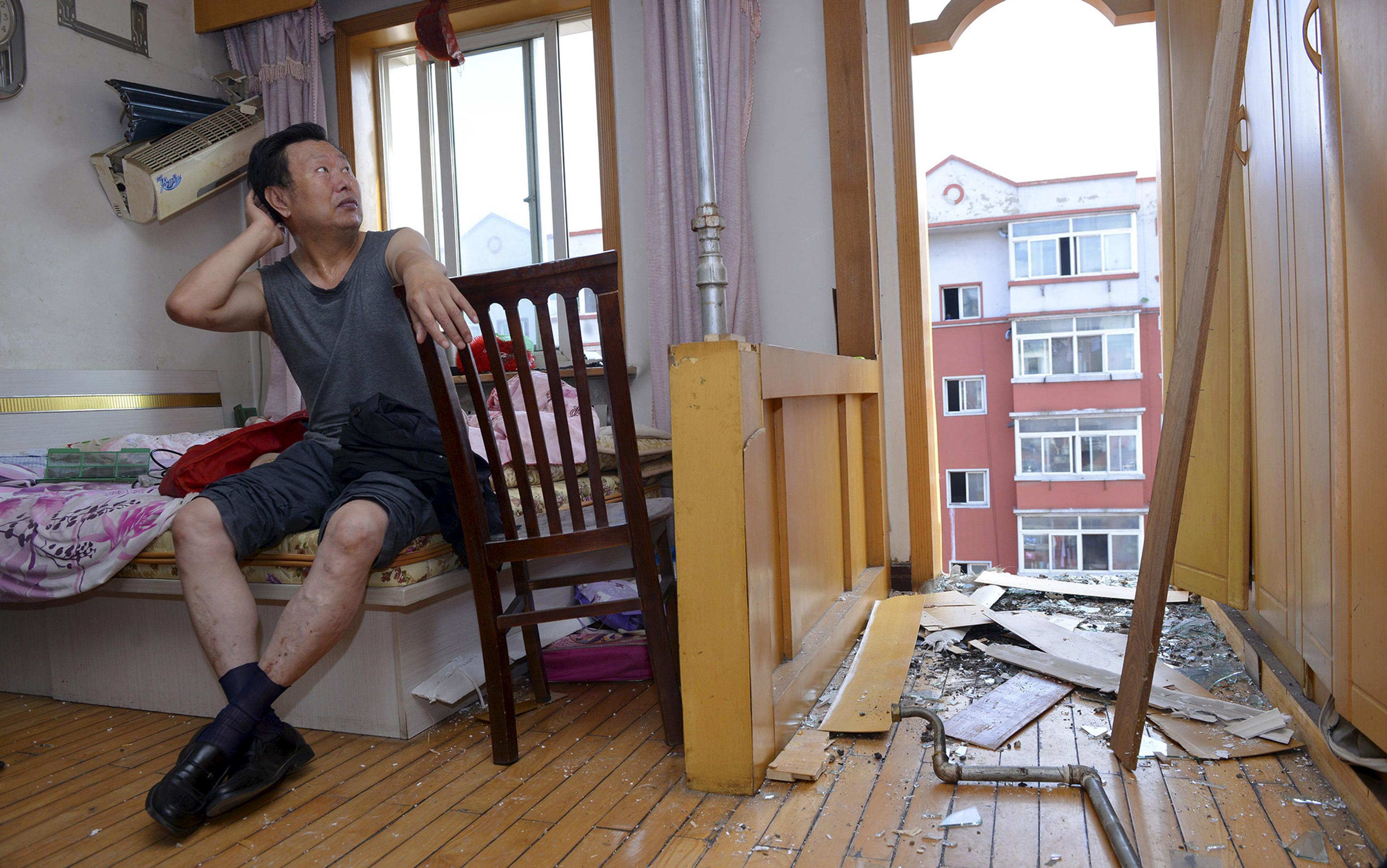When I sit down with Ai Weiwei, the first thing he does is aim his iPhone at me. We are in Ai’s cathedral-like home-cum-studio, in the dusty village of Caochangdi, on Beijing’s outskirts. Winter sunlight streams through vast windows into an expansive room, sparsely decorated with a large potted ginkgo tree and a headless Buddha. While the dimensions of his living space soar, Ai is trapped in a goldfish bowl. China’s most famous dissident and artist is tagged by authorities wherever he goes – his phones are tapped, his home bugged. Outside his now iconic green gate, a surveillance camera bears down menacingly.
Somewhere, deep within the bowels of the Chinese Communist Party, Ai’s life concurrently exists on film. But, with characteristic mischief, the artist has turned the table on his tormentors and provided them with what they want for free. While they record Ai, he records himself, relaying his movements (and those of people around him) to the world in a constant stream, via Twitter and Instagram. On this freezing January morning, as I wait for our interview to begin, he presses a button. Without asking, he takes my photograph and I become part of the media montage that is inextricable from the artist Ai Weiwei.
Ever since he was arrested and kept in secret detention for 81 days, in April 2011, Ai has been living in limbo. His company has been charged with tax evasion (economic crimes are routinely levelled against dissidents) and he’s been investigated for pornography and bigamy, the latter a result of fathering a son from an extramarital relationship. Today, Ai can, within limits, move around China. But the regime has retained his passport, preventing foreign travel and making his exhibitions abroad – the only place he can exhibit – a logistical nightmare.
To object, he tethered a bicycle outside his studio last November. Every day, he places fresh flowers in its basket, takes a photograph, and posts the image online. This gentle protest, which offers a palate of bright relief against the polluted skies, will continue until his passport is returned. Till then, incessantly reminding the state of his presence has become his trademark tool. ‘Today, protest doesn’t have to be a walk on the street or hold[ing] a banner, but a statement of existing, repeatedly re-announcing your position,’ he says, in accented English.
Ai’s studio, called 258 Fake, has become China’s equivalent of Andy Warhol’s Factory. And Ai himself has increasingly taken on Warholian overtones: there is now little distinction between Ai the artist who creates artworks, and Ai the dissident who gets beaten by the cops. (In 2009, police pummelled his face, causing a cerebral haemorrhage.) Both are merged in an ongoing performance in which the man has become the art, and the art is the man. ‘Every image of him is part of this overarching public persona. And, in a way, that persona is his greatest artwork,’ says Philip Tinari, director of Beijing’s Ullens Center for Contemporary Art (UCCA).
Following Ai’s arrest, work at the studio slowed to a near halt. But three years later, it is a hive of frenzied activity. The office door opens constantly as people come and go, letting in gusts of cold air. Assistants – Ai has 40 working for him, many of them living on site – tap away at computers under harsh strip lighting, wrapped in coats and scarfs. One Western girl discusses ‘Fake’, Ai’s brand, loudly on the phone, a fat cat purring on her lap.
On the back wall is a list of names in tiny print. They record the identities of the 5,196 children who perished in the 2008 Sichuan earthquake. They died when their ‘tofu-dreg schools’ – so named because of the buildings’ flimsy structures – collapsed. In his Citizens’ Investigation project, Ai led more than 50 volunteers in a mission to uncover the victims’ details, working in defiance of the local government, which had attempted to cover up its own incompetence. It was, Ai has said, perhaps ‘the first large-scale… media-concentrated civil act in China’.
I ask if the government is still afraid of him. ‘Afraid of me?’ he says, stretching the last vowel to emphasise his incredulity. ‘If I can freely express myself, they have reason to be afraid of me. But if my words cannot get on the [Chinese] internet or newspaper or any media, then why are they so afraid of me?’
Inside China, Ai’s impact is neutralised: domestic media cannot mention his name. He talks about being officially cast as a ‘disease’, since the government worries that his calls for free speech and universal human rights might spread like a virus. In the West, he has become the cause célèbre of dissidence in China and is perhaps the country’s most recognised global figure. Yet paradoxically, at home, most of the population has no idea who Ai is. He has effectively been eradicated from the public sphere.
For a minority of Chinese bloggers, activists, lawyers and other young savvy internet users, Ai is a beacon of resistance. Since his release, he says people stop him in the street to shake his hand. When he travels in China, he uses his Twitter account – he has more than 240,000 followers (though banned in China, Twitter can be accessed via a virtual private network) – to organise impromptu meals for his supporters. It is people such as these who, when Ai was saddled with a 15 million yuan ($2.4 million) tax fine, folded bank notes into paper planes and flew them over the walls into the 258 Fake studio.
At the heart of the matter is the Communist Party’s shaky claim to legitimacy. ‘You know, not my father’s generation, not my generation, not even my son’s generation will see voting,’ Ai passionately says. ‘So nobody can exercise their rights in public, [have] public opinions, or give anything related to public expression. That indicates several things: first you [the Party] are not legitimate, you can never be confident… So that puts you on a very fragile base. This is a fundamental philosophical problem. China has an identity crisis and is not intending to fix it.’
His homely look – Santa Claus belly, bushy beard and brows – belies a steely personality
I first interviewed Ai in the summer of 2012. Afterwards I took his portrait at the request of the American newspaper I was writing for. It made me nervous: I was no photographer, and sheepishly admitted that I didn’t really know what I was doing. Rather than roll his eyes, Ai patiently posed by the window, standing this way and that. When I was done, I showed him the images. ‘See,’ he said, touching my arm gently. ‘You’re good. You just need confidence.’
This time, a different Ai is on display. He seems bored, distracted. As he talks, he simultaneously takes, and then flicks through, snapshots of his cats (dozens, all fluffy and well-fed, live in the studio). At one point he lifts his body off his chair by his arms, and swings back and forth impatiently. Then he films me unprompted: it is a disconcerting moment. But then Ai is a complex character – charismatic, magnetic, playful, and with a razor-sharp wit. He can be uncompromising, even fierce. His homely look – Santa Claus belly, bushy beard and brows – belies a steely personality.
This can be switched on with surprising ferocity. When his son, now aged five, was a baby, Ai recalls being persistently followed by a man posing as a tourist. Finally, an exasperated Ai snatched away the man’s camera and confiscated the memory card. He says that he wanted to be proved wrong, to be proved paranoid. But when he took the card home and plugged it into his computer, he uncovered a relay of his movements: ‘The restaurant, the dinner I had yesterday, every room, the staircase, the cashier area, my driver sitting on the park bench, his shoes, also my child’s [buggy].’ Another time, he smashed a plain-clothes officer’s phone. ‘I kicked his ass. But he wouldn’t even turn back his face because I was filming. He just walked away,’ Ai says with a small satisfied grunt.
Surveillance has bordered on the absurd. Police have approached two of Ai’s assistants, offering them cash to spy on the artist (they did not accept). ‘I think, how ridiculous,’ he says, leaning forward from his chair. ‘I am seeking for openness and the exchange of ideas. I never want to hide anything.’ Ai suggested to the police that instead they come and work as his assistants. ‘If I can accept any student, I can accept you,’ he told them, letting forth a great belly laugh at the memory. ‘Just see how bad I am, report everyday, and you will get promoted.’
Ai grew up in exile in the wilds of China’s far western Xinjiang province with his persecuted poet father. Ai Qing had been one of China’s most prominent literary figures but, like many intellectuals, he fell into disgrace during the Anti-Rightist Campaign of the late 1950s. The family was sent first to Manchuria, then to Xinjiang, where Ai watched his father reduced to cleaning toilets. During the Cultural Revolution, they spent five years on the fringes of the Gobi Desert living in an underground cave designed for farm animals. In 1981, with China still reeling from the social experiments of the Maoist-era, Ai left for America and the hedonistic verve of the New York art scene.
He stayed until 1993, returning to China only when his father became ill. ‘Of course, nobody cares about you. [I was] very, very alone like a beast,’ he says of his years away. Alone maybe. But, for the first time, Ai also practised total self-determination. Art gave him deliverance. ‘I was forced to become [an artist] because the time when we grew up, the whole society was almost one set of values,’ he says. ‘And being an artist you can create another type of rules to look at, or judge, your actions. So that gave me some liberty.’
Ai became an artist ‘to escape from politics’. He is only too aware of the irony that politics now consumes his art. When I question whether art can just be beautiful, he is flabbergasted. ‘Wow, just beautiful. You mean, to please the mind or to please the eye? If it’s just to please the eye… that’s possible but normally you don’t call it art. If the brain has to make some kind of judgment, then it always takes a stand. Art doesn’t need to be political, but art is political.’
Within the global art scene, Ai straddles a unique space: somewhere between superstar artist, sacrificial freedom-fighter, and social media sage
In his book of quotations Weiwei-isms (2012), Ai writes that art is ‘about freedom of expression, a new way of communication. It is never about exhibiting in museums or about hanging it on the wall… I don’t think anybody can separate art from politics.’
It is a world-view that can verge on the dogmatic. In 2012, Ai wrote an opinion piece for The Guardian titled ‘China’s Art World Does Not Exist’. It was a scathing critique of a group exhibition of Chinese artists then showing at the Hayward gallery in London. ‘In a society that restricts individual freedoms and violates human rights, anything that calls itself creative or independent is a pretence,’ Ai railed. ‘It is impossible for a totalitarian society to create anything with passion and imagination.’ Art, he concluded, ‘needs to stand for something’.
Tinari, the UCCA director, says: ‘He is disappointed that artists have not stepped up in the same way that he has to what he considered a vile political situation.’ But the article ‘more or less claims that there were no real artists in China other than him. Which really was, for me, a bit of a disappointment. I’ve advocated his work for a long time, and I do believe he is one of the greats – if not the great – contemporary talents in China. At the same time, I think it’s dangerous to start thinking that there is only one way to resist.’
Ai’s courage, his absolute conviction about his chosen path, has separated him from his peers in China, many of whom are eager to cash in on a now billion-dollar art industry, or are at least resigned to working within the constraints of the country. Yet his influence on the art scene cannot be overstated. ‘It’s like the question of: do you believe in God or not? It almost doesn’t matter whether he exists because he looms so large,’ Tinari says. And like God, Ai has his fair share of sceptics and scoffers. Critics believe that he plays up foreign sympathies and simplifies the complex reality of China today. Others pour scorn on his position in the West as a poster boy for resistance.
Still others criticise Ai for what they see as a continual stream of self-promotion and ‘look at me’ tactics on social media; examples include a cringeworthy video of him dancing Gangnam Style or Instagram pictures of him jumping around naked, his privates covered only with a stuffed toy. To his supporters, this is a small price to pay for someone willing to speak out. ‘Yes, he is a self-promoter, as many artists are. But a big part of what he is promoting is trying to get you to engage and communicate. I don’t think he needs to do it to raise the value of his art… There is plenty of money to be made as a darling in China without ruffling any feathers,’ says Alison Klayman, director of the documentary Ai Weiwei: Never Sorry (2012).
Within the global art scene, Ai straddles a unique space: somewhere between superstar artist, sacrificial freedom-fighter, and social media sage. Growing up under Mao, information flowed only one way: from the Party to the people. For Ai, then, the fluid back-and-forth of social media offers utopian promise.
Yet it is mass communication – the use of art combined with micro-blogs to rally people behind a particular cause – that has proved particularly dangerous for Ai. In Maoist China, thought crimes against the state could be cause for jail or even execution. Today, artists and writers, though censored, are rarely locked up for their works alone. But calls for civil action, viewed as a threat by the Party, are seldom tolerated.
Despite his trials, Ai has produced prolifically and shown a talent for innovation and change. His works often question Chinese cultural pretensions and entrenched hierarchies. Dropping a Han Dynasty Urn (1995), in which he smashes a 2,000-year-old antique, gives an irreverent middle finger to China’s claims to an unbroken civilisation of thousands of years. In an image of Tiananmen Square from a series called Study of Perspective (1995-2011) Ai went a step further and photographed himself literally giving the finger to a square that symbolises the Party’s power and betrays its past bloodshed.
In Weiwei-isms, Ai called upon the people ‘to be “obsessed citizens”, forever questioning and asking for accountability’. He stands by his own words. Many of his works are inseparable from his activism (for example, Snake Ceiling (2009), a serpent sculpture made from children’s backpacks was built to commemorate the Sichuan earthquake). But just as Ai promotes the very real weight of his social causes, he also, tongue in cheek, undermines his own position as an artistic poseur.
‘How do you make your opinion legitimate or credible? I don’t really know what I would become if I moved away’
Warhol once said of his paintings: ‘There’s nothing behind it.’ Likewise, the name ‘Fake’ demonstrates a wry understanding of the flippant, often throwaway nature of art, subject as the market is to wild speculation. This can bubble to the surface. In 2012, I tried to guide the conversation away from Ai’s imprisonment towards a show he had coming up in Washington DC. He protested tetchily: ‘Back to the DC show? I already forget the DC show!’
If there is a thread holding his works together, it is his mixture of bold confrontation, intellectual playfulness, droll humour, and experimentation of form. Beauty is second to social critique. This is not to say that Ai eschews the aesthetic. Far from it. His dazzling Sunflower Seeds (2010), in which Ai filled the hallowed Turbine Hall of Tate Modern in London with millions of seed husks handcrafted in porcelain, was a searing indictment of mass production in China. It was also ravishing to look at.
When our interview is done, Ai invites me to eat at a local restaurant across the street from his studio. It’s decked in vintage televisions and old rusty radios, and heaving with the lunchtime crush. Ai picks a selection of homestyle dishes: spicy Sichuan sausage, oozing with oil, fluffy stir-fried egg and tomato, cloggy shredded potato. He remains in a reflective mood, yet still holds court. While he talks to a local curator on his left, four or five assistants at the table with us largely eat in silence.
But the atmosphere is also festive. Ai calls out warmly to yet more assistants who settle at a table nearby and chats to a young hip designer he calls his ‘niece’ who sports a faux-fur jacket and giant sunglasses, giggling as she leans in. When I slurp up the remains of a bowl of noodles, he nods to me, impressed: ‘Finished so much? You’re great!’ Such meals are commonplace. ‘You go to dinner and there are 30 people at the table, every meal. And he pays for it all. His art is this incredible engagement, his art is everything. He’s not fucking around, he really does care,’ says the feted cinematographer Christopher Doyle, who worked with Ai on the music video Dumbass (2013).
Of course, spectators are essential to dissidents, as to artists. It is hard to tell with Ai if it is ego or selflessness, or a combination of both, that drive him forward day upon day, year upon year. If Ai could seek asylum abroad, it’s doubtful that he would go. He is planning to open a studio in Berlin but is unlikely to move there permanently, even if his passport is returned. China is where he remains most relevant, and China feeds his creativity. ‘How do you make your opinion legitimate or credible?’ Ai asks. ‘Actually I don’t really know what I would become [if I moved away].’
Ai once admitted to the Chinese newspaper Southern Weekend that ‘being threatened is addictive. When those in power are infatuated with you, you feel valued.’ I ask whether that is still true. He thinks for a moment. ‘When you feel this kind of power, which affects so many people’s lives, their happiness, their possibilities, their joy, and then you think you can shape that, and you have a way to change it, that is exciting,’ he says.
But then he adds: ‘Sometimes it feels so lonely.’ How can you feel lonely, I protest, with all these people around you? The assistants, the friends, the foreign visitors, the hordes of social media followers, even the police and the authorities, all of whom, for better or worse, care where you are and what you are doing? ‘I do, I do, I do,’ he insists. ‘People have good will to help you, but you still have to do the job. You have a certain vision or goal – a certain belief. You are doing it alone.’
